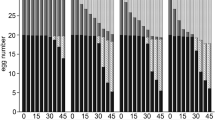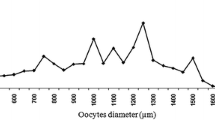Abstract
In a laboratory batch culture experiment, females of Daphnia magna were exposed to five different experimental media containing either:(1) water from an aquarium with fish, (2) extract of fish faeces, (3) mixture of both media, (4) extract of homogenised conspecific Daphnia, or (5) control water without the addition of extra cues. The experiment was planned to test potential pathways of excretion of the chemical cues that induce resting-egg formation in D. magna and to find an effective way of collecting these chemical cues. The results indicate that fish faeces are the prevailing source of the chemical cues that induce resting-egg production in D. magna. The ease of collection and the possibility of storing it in a frozen state make it a convenient cue for inducing diapause response in Daphnia. The results of the experiment imply that in natural conditions Daphnia may face high concentration of the inductive signals once migrating to the bottom zone where fish faeces commonly accumulate.
Similar content being viewed by others
References
Danks, H. V., 1987. Insect Dormancy: An Ecological Perspective — Biological Survey of Canada, Monogr. Ser. 1, National Museum of Natural Sciences, Ottawa.
Hairston, N. G., 1987. Diapause as a predator-avoidance adaptation, pp.281-290. In Kerfoot, W.C. & A. Sih (eds), Predation: Direct and Indirect Impacts on Aquatic Communities. University Press of New England, Hanover and London.
Hairston, N. G. & C. M. Kearns, 1995. The interaction of photoperiod and temperature in diapause timing: a copepod example. Biological Bulletin 189: 42-48.
Hofer, R., H. Forstner & R. Rettenwander, 1982. Duration of gut passage and its dependence on temperature and food consumption in roach, Rutilus rutilus L: laboratory and field experiments. Journal of Fish Biology 20: 289-299.
Hofer, R., & A. Nasir Uddin, 1985. Digestive processes during the development of the roach, Rutilus rutilus L. Journal of Fish Biology 26: 683-689.
Loose, C. J., E. Von Elert & P. Dawidowicz, 1993. Chemicallyinduced diel vertical migration in Daphnia: a new bioassay for kairomone exuded by fish. Archives of Hydrobiology 126: 329-337.
Loose, C. J. & P. Dawidowicz, 1994. Trade-offs in diel vertical migration by zooplankton: the costs of predator avoidance. Ecology 75: 2255-2263.
Pijanowska, J. & G. Stolpe, 1996. Summer diapause in Daphniaas a reaction to the presence of fish.Journal of Plankton Research 18: 1407-1412.
Slusarczyk, M., 1995. Predator-induced diapause in Daphnia. Ecology 76: 1008-1013.
Slusarczyk, M., 1999. Predator-induced diapause in D. magna may require two chemical cues. Oecologia 119: 159-165.
Threlkeld, S. T., 1979. The midsummer dynamics of two Daphnia species in Wintergreen lake, Michigan. Ecology 60: 165-179.
Author information
Authors and Affiliations
Rights and permissions
About this article
Cite this article
Ślusarczyk, M., Rygielska, E. Fish Faeces as the Primary Source of Chemical Cues Inducing Fish Avoidance Diapause in Daphnia Magna . Hydrobiologia 526, 231–234 (2004). https://doi.org/10.1023/B:HYDR.0000041599.56610.b4
Issue Date:
DOI: https://doi.org/10.1023/B:HYDR.0000041599.56610.b4




